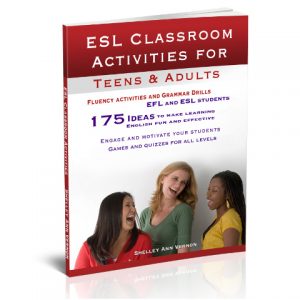Here are some ideas for teaching present the continuous. These games and many more are in ESL Classroom Activities for Teens and Adults, available in Paperback and instant Download.
Teaching the present continuous by demonstration
First, explain that the present continuous is happening NOW – it’s real-time. In addition, the future meaning of the present continuous also exists, for example, “What are you doing on Monday?” However, you might want to leave that for a different lesson because it can be confusing to teach two new concepts at once.
Start by miming actions to indicate that they are happening now. For instance, say, “I am walking to the end of the class.” Repeat this while you are walking. “I am writing on the board” while you are writing.
Present continuous tense listening game
First, bring three students up to the front and tell them to mime an action they know how to say in English. For example, drinking, eating, running, walking, talking, etc. Give the students the action written on a piece of paper if they do not have enough ideas – have those ready in advance.
Tell all three students to start miming their actions simultaneously – each one mimes something different. Then you say one of them, “He is drinking,” and the class calls out the name of the student drinking. Then say, “She is walking,” and the students name the one who is walking.
Tell all three students to start miming their action at the same time – three different actions. Then you say one of them – “He is drinking” – and the class calls out the name of the student who is drinking. Then say, “She is walking” – and the students name the one who is walking.
Speaking drill game 2
Next, try this speaking game to liven up teaching the present continuous. This activity is relevant for the present and future uses of the tense. First, do a class brainstorm activity where A asks B on a date or outing. However, B doesn’t want to go and has to come up with an excuse why not. As long as the answer is grammatically correct, it doesn’t matter how crazy it is. First, give students some examples, such as, “Do you want to come to the cinema?” “I can’t. I’m doing my homework.”
Next, divide the class into two or three teams. Now ask students, “Would you like to come to town with me?” Next, the teams call out reasons they can’t come. For instance, I can’t; I’m washing my hair, I’m eating lunch, I’m meeting my parents, I’m watching TV, I’m meeting my boyfriend, or I’m catching squirrels in my basement. Award a point for every reason a team gives.
Tips
Give double points for original answers if you like, since that could encourage creativity and make it more fun.
Make a rule that a person cannot give more than one reason per minute. Tell students to respect this rule because their team loses all their points and starts at zero again should you catch anyone out! This rule should prevent one person from taking over and give the others a chance to think of things and participate. Top students can keep score while playing the game simultaneously because they need extra tasks to stay interested. The teacher, therefore, can concentrate on running the game.
Let teams call out answers randomly; as soon as students think of something, they call it out to keep the pace moving. It’s boring if you go around one student after the other, methodically, unless you only have a handful of students. As mentioned above, a student could keep score for each team.
FIND A FRIEND – present continuous
Have students think of an activity, mime it, go around the class asking others, “What are you doing?” The other student replies. If it is the same activity, they pair up. If not, they continue looking. When students find others doing the same thing, they group together.
Tip
Before you start, say that the winners will be unique, with no others doing the same activity, or the winners will be those who found the most other people doing the same activity. But you won’t announce which one it is until the game is over.
Writing drill for teaching the present continuous
Divide the class into teams and bring a representative of each one to the board. On “Go,” the students start writing sentences in the present continuous, but only for as long as they can hold their breath. When they run out of breath, they return to their seat, and number two in the team comes up and takes over. Continue until each team member has had a turn. Then read the sentences and see which team has written the most. Only correct sentences earn a point!
Tips
With more than 20 students, use big sheets of paper instead of the board. Stick these around the classroom and make teams of 4 to 5 students per team. This prevents everyone from getting bored sitting around waiting for a turn. If all students have computers or phones, you might have a digital solution for this idea.
Have a couple of students act as judges. They circulate and observe players. Anyone caught cheating (taking a breath while writing) is out, not only that person but their whole team.

These games and many more are in ESL Classroom Activities for Teens and Adults. In Paperback or from your local bookstore, and in instant Download. Use this book of online games instead if you are teaching online!
You might also like my book of skits for teens. It includes an easy role-play for the present continuous for now, a longer skit that includes present continuous for now, and a third skit for the present continuous for future.
All the best
Shelley Ann Vernon
-
Sale Product on sale
 Plays and Skits for Teens
Plays and Skits for Teens€19.97Original price was: €19.97.€15.33Current price is: €15.33.Rated 5.00 out of 5 based on 1 customer rating -
Sale Product on sale
 Games and Activities for Teens and Adults
Games and Activities for Teens and Adults€19.97Original price was: €19.97.€15.33Current price is: €15.33.Rated 5.00 out of 5 based on 12 customer ratings -
 ESL Online Games€19.97Rated 5.00 out of 5 based on 4 customer ratings
ESL Online Games€19.97Rated 5.00 out of 5 based on 4 customer ratings




2 thoughts on “Teaching the present continuous to teens”
I would love to know when your new book is out. Thanks
Dear Brenda,
Hello there and I hope all is well. This book of teen skit is available. It is in download from me, and, in the case of this particular book, I think that is the best format since you can easily print off a skit if need be. But if you prefer, it’s in paperback too, on Amazon. Here is a link to it:
skits-for-teens
All the best
Shelley